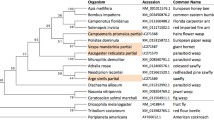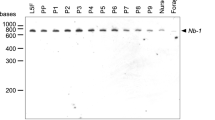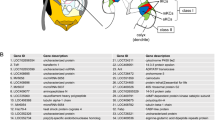Abstract
Honeybees have been shown to exhibit cognitive performances that were thought to be specific to some vertebrates. However, the molecular and cellular mechanisms of such cognitive abilities of the bees have not been understood. We have identified a novel gene, Mahya, expressed in the brain of the honeybee, Apis mellifera, and other Hymenoptera. Mahya orthologues are present in Deuterostomes but are absent or highly diverged in nematodes and, intriguingly, in two dipteran insects (fruit fly and mosquito) and Lepidoptera (silk moth). Mahya genes encode novel secretory proteins with a follistatin-like domain (Kazal-type serine/threonine protease inhibitor domain and EF-hand calcium-binding domain), two immunoglobulin domains, and a C-terminal novel domain. Honeybee Mahya is expressed in the mushroom bodies and antennal lobes of the brain. Zebra fish Mahya orthologues are expressed in the olfactory bulb, telencephalon, habenula, optic tectum, and cerebellum of the brain. Mouse Mahya orthologues are expressed in the olfactory bulb, hippocampus, and cerebellum of the brain. These results suggest that Mahya may be involved in learning and memory and in processing of sensory information in Hymenoptera and vertebrates. Furthermore, the limited existence of Mahya in the genomes of Hymenoptera and Deuterostomes supports the hypothesis that the genes typically represented by Mahya were lost or highly diverged during the evolution of the central nervous system of specific Bilaterian branches under the specific selection and subsequent adaptation associated with different ecologies and life histories.






Similar content being viewed by others
References
Ashburner M (1989) Drosophila a laboratory manual. Cold Spring Harbor Laboratory Press, New York
Balemans W, Hul WV (2002) Extracellular regulation of BMP signaling in vertebrates: a cocktail of modulators. Dev Biol 250:231–250
Carpenter FM, Burnham L (1985) The geological record of insects. Annu Rev Earth Planet Sci 13:297–314
Datta S, Mori Y, Takagi K, Kawaguchi K, Chen ZW, Okajima T, Kuroda S, Ikeda T, Kano K, Tanizawa K, Mathews FS (2001) Structure of a quinohemoprotein amine dehydrogenase with an uncommon redox cofactor and highly unusual crosslinking. Proc Natl Acad Sci U S A 98:14268–14273
Fahrbach SE, Robinson GE (1995) Behavioral development in the honey bee: toward the study of learning under natural conditions. Learn Mem 2:199–224
Funada M, Yasuo S, Yoshimura T, Ebihara S, Sasagawa H, Kitagawa Y, Kadowaki T (2004) Characterization of the two distinct subtypes of metabotropic glutamate receptor from honeybee, Apis mellifera. Neurosci Lett 359:190–194
Giurfa M, Zhang S, Jenett A, Menzel R, Srinivasan MV (2001) The concepts of ‘sameness’ and ‘difference’ in an insect. Nature 410:930–933
Ishihara A, Saito H, Abe K (1994) Transforming growth factor-beta 1 and -beta 2 promote neurite sprouting and elongation of cultured rat hippocampal neurons. Brain Res 639:21–25
Kikuno R, Nagase T, Nakayama M, Koga H, Okazaki N, Nakajima D, Ohara O (2004) HUGE: a database for human KIAA proteins, a 2004 update integrating HUGEppi and ROUGE. Nucleic Acids Res 32(database issue):D502–D504
Kortschak RD, Samuel G, Saint R, Miller DJ (2003) EST analysis of the Cnidarian Acropora millepora reveals extensive gene loss and rapid sequence divergence in the model invertebrates. Curr Biol 13:2190–2195
Menzel R, Giurfa M (2001) Cognitive architecture of a mini-brain: the honeybee. Trends Cogn Sci 5:62–71
Menzel R, Muller U (1996) Learning and memory in honeybees: from behavior to neural substrates. Annu Rev Neurosci 19:379–404
Mineta K, Nakazawa M, Cebria F, Ikeo K, Agata K, Gojobori T (2003) Origin and evolutionary process of the CNS elucidated by comparative genomics analysis of planarian ESTs. Proc Natl Acad Sci U S A 100:7666–7671
Mushegian AR, Garey JR, Martin J, Liu LX (1998) Large-scale taxonomic profiling of eukaryotic model organisms: a comparison of orthologous proteins encoded by the human, fly, nematode, and yeast genomes. Genome Res 8:590–598
Portavella M, Torres B, Salas C (2004) Avoidance response in gold fish: emotional and temporal involvement of medial and lateral telencephalic pallium. J Neurosci 24:2335–2342
Prechtl JC, von der Emde G, Wolfart J, Karamursel S, Akoev GN, Andrianov YN, Bullock TH (1998) Sensory processing in the pallium of a mormyrid fish. J Neurosci 18:7381–7393
Sacchetti B, Baldi E, Lorenzini CA, Bucherelli C (2002) Cerebellar role in fear-conditioning consolidation. Proc Natl Acad Sci U S A 99:8406–8411
Shi Y, Massague J (2003) Mechanisms of TGF-beta signaling from cell membrane to the nucleus. Cell 113:685–700
Tsuchimoto M, Aoki M, Takada M, Kanou Y, Sasagawa H, Kitagawa Y, Kadowaki T (2004) The changes of gene expression in honeybee (Apis mellifera) brains associated with ages. Zoolog Sci 21:23–28
Whitfield CW, Brand MR, Bonaldo MF, Kumar CG, Liu L, Pardinas JR, Robertson HM, Soares MB, Robinson GE (2002) Annotated expressed sequence tags and cDNA microarrays for studies of brain and behavior in the honey bee. Genome Res 12:555–566
Yanez J, Anadon R (1996) Afferent and efferent connections of the habenula in the rainbow trout (Oncorhynchus mykiss): an indocarbocyanine dye (Dil) study. J Comp Neurol 372:529–543
Yoshida M, Okamura I, Uematsu K (2004) Involvement of the cerebellum in classical fear conditioning in gold fish. Behav Brain Res 153:143–148
Yoshimoto M, Ito H (1993) Cytoarchitecture, fiber connections, and ultrastructure of the nucleus pretectalis superficialis pars magnocellularis (PSm) in carp. J Comp Neurol 336:433–446
Yoshimura T, Suzuki Y, Makino E, Suzuki T, Kuroiwa A, Matsuda Y, Namikawa T, Ebihara S (2000) Molecular analysis of avian circadian clock genes. Brain Res Mol Brain Res 78:207–215
Zdobnov EM, von Mering C, Letunic I, Torrents D, Suyama M, Copley RR, Christophides GK, Thomasova D, Holt RA, Subramanian GM, Mueller H-M, Dimopoulos G, Law JH, Wells MA, Birney E, Charlab R, Halpern AL, Kokoza E, Kraft CL, Lai Z, Lewis S, Louis C, Barillas-Mury C, Nusskern D, Rubin GM, Salzberg SL, Sutton GG, Topalis P, Wides R, Wincker P, Yandell M, Collins FH, Ribeiro J, Gelbart WM, Kafatos FC, Bork P (2002) Comparative genome and proteome analysis of Anopheles gambiae and Drosophila melanogaster. Science 298:149–159
Acknowledgements
We thank M. Mizunami for helpful discussion. This study was supported by Grant-in-Aid for Scientific Research from the Japan Society for the Promotion of Science to T.K.
Author information
Authors and Affiliations
Corresponding author
Additional information
Communicated by C. Desplan
Rights and permissions
About this article
Cite this article
Tsuchimoto, M., Yasuo, S., Funada, M. et al. Conservation of novel Mahya genes shows the existence of neural functions common between Hymenoptera and Deuterostome. Dev Genes Evol 215, 564–574 (2005). https://doi.org/10.1007/s00427-005-0021-z
Received:
Accepted:
Published:
Issue Date:
DOI: https://doi.org/10.1007/s00427-005-0021-z




